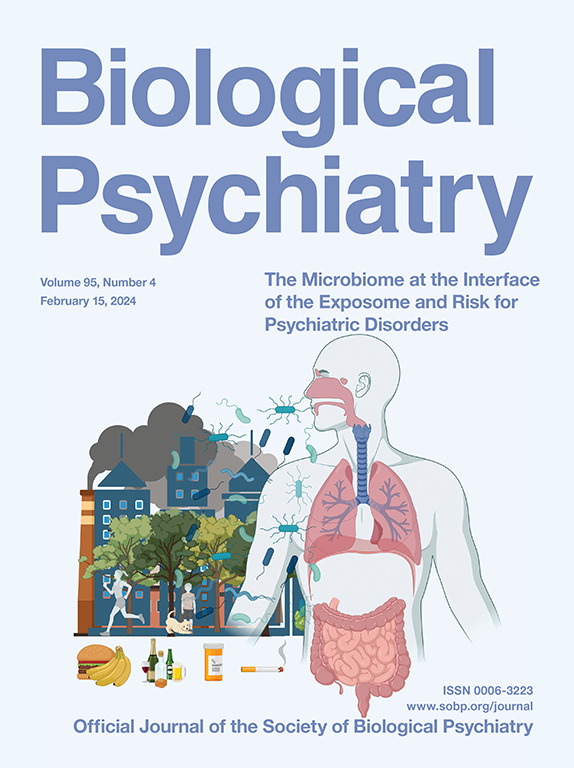Connections Between the Middle Frontal Gyrus and the Dorsoventral Attention Network Are Associated With the Development of Attentional Symptoms
IF 9.6
1区 医学
Q1 NEUROSCIENCES
引用次数: 0
Abstract
Background
The right middle frontal gyrus (MFG) has been proposed as a convergence site for the dorsal attention network (DAN) and ventral attention network (VAN), regulating both networks and enabling flexible modulation of attention. However, it is unclear whether the connections between the right MFG and these networks can predict changes in attention-deficit/hyperactivity disorder (ADHD) symptoms.
Methods
This study used data from the Children School Functions and Brain Development project (N = 713, 56.2% boys). Resting-state functional magnetic resonance imaging was employed to analyze the connections of the right MFG with the DAN/VAN; connectome-based predictive modeling was applied for longitudinal prediction, and ADHD polygenic risk scores were used for genetic analysis.
Results
ADHD symptoms were associated with the connections between the right MFG and DAN subregion, including the frontal eye field, as well as the VAN subregions, namely the inferior parietal lobule and inferior frontal gyrus. Furthermore, these connections of the right MFG with the frontal eye field, the inferior parietal lobule, and the inferior frontal gyrus could significantly predict changes in ADHD symptoms over 1 year and mediate the prediction of ADHD symptom changes by polygenic risk scores for ADHD. Finally, the validation samples confirmed that the functional connectivity between the right MFG and the frontal eye field/inferior parietal lobule in patients with ADHD was significantly weaker than that in typically developing control participants, and this difference disappeared after medication.
Conclusions
The connection of the right MFG with the DAN and VAN can serve as a predictive indicator for changes in ADHD symptoms over the following year, while also mediating the prediction of ADHD symptom changes by a polygenic risk score for ADHD. These findings hold promise as potential biomarkers for early identification of children who are at risk of developing ADHD.
额叶中回和背腹部注意力网络之间的连接与注意力症状的发展有关。
背景:右侧MFG被认为是DAN和VAN的汇聚点,它同时调节这两个网络并实现对注意力的灵活调节。然而,目前尚不清楚右侧MFG与这些网络之间的联系能否预测多动症症状的变化:本研究使用了儿童学校功能和大脑发育项目的数据(n = 713,56.2% 为男孩)。静息态fMRI用于分析右侧MFG与DAN/VAN的连接,基于连接体的预测模型用于纵向预测,ADHD PRS用于遗传分析:结果:ADHD症状与右侧MFG与DAN亚区(包括FEF)以及VAN亚区(即IPL和IFG)之间的连接有关。此外,右侧MFG与FEF、IPL和IFG之间的这些联系可以显著预测一年内ADHD症状的变化,并对ADHD PRS预测ADHD症状变化起到中介作用。最后,验证样本证实,多动症患者右侧MFG与FEF/IPL之间的功能连接明显弱于发育正常的对照组,而且这种差异在服药后消失:结论:右侧MFG与DAN和VAN之间的连接可作为下一年ADHD症状变化的预测指标,同时也是ADHD PRS预测ADHD症状变化的中介。这些发现有望成为早期识别有患多动症风险的儿童的潜在生物标志物。
本文章由计算机程序翻译,如有差异,请以英文原文为准。
求助全文
约1分钟内获得全文
求助全文
来源期刊

Biological Psychiatry
医学-精神病学
CiteScore
18.80
自引率
2.80%
发文量
1398
审稿时长
33 days
期刊介绍:
Biological Psychiatry is an official journal of the Society of Biological Psychiatry and was established in 1969. It is the first journal in the Biological Psychiatry family, which also includes Biological Psychiatry: Cognitive Neuroscience and Neuroimaging and Biological Psychiatry: Global Open Science. The Society's main goal is to promote excellence in scientific research and education in the fields related to the nature, causes, mechanisms, and treatments of disorders pertaining to thought, emotion, and behavior. To fulfill this mission, Biological Psychiatry publishes peer-reviewed, rapid-publication articles that present new findings from original basic, translational, and clinical mechanistic research, ultimately advancing our understanding of psychiatric disorders and their treatment. The journal also encourages the submission of reviews and commentaries on current research and topics of interest.
 求助内容:
求助内容: 应助结果提醒方式:
应助结果提醒方式:


